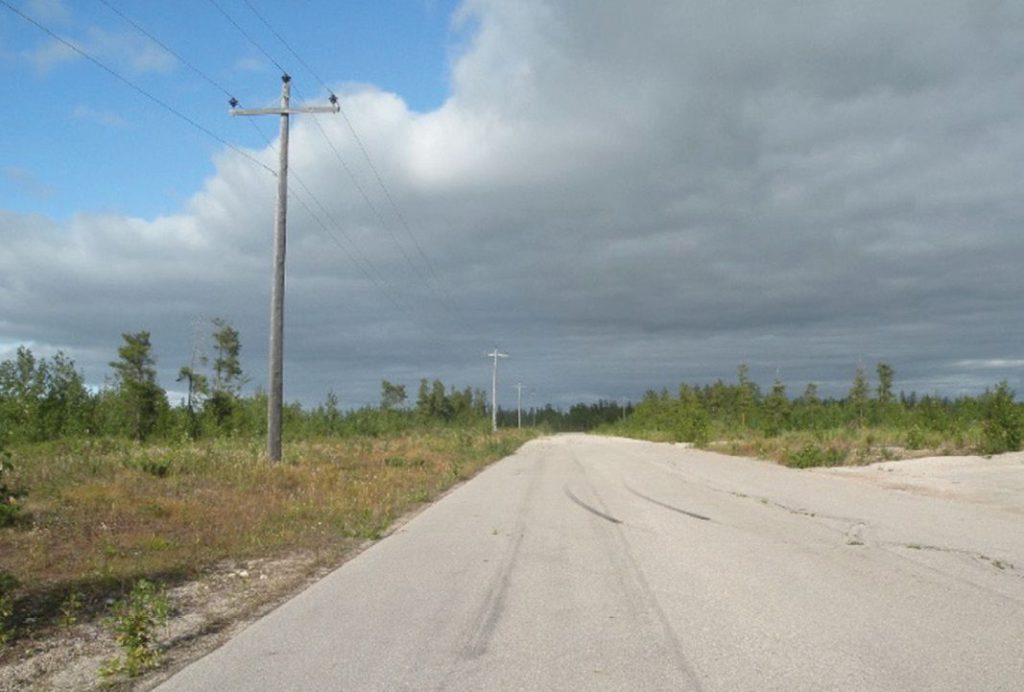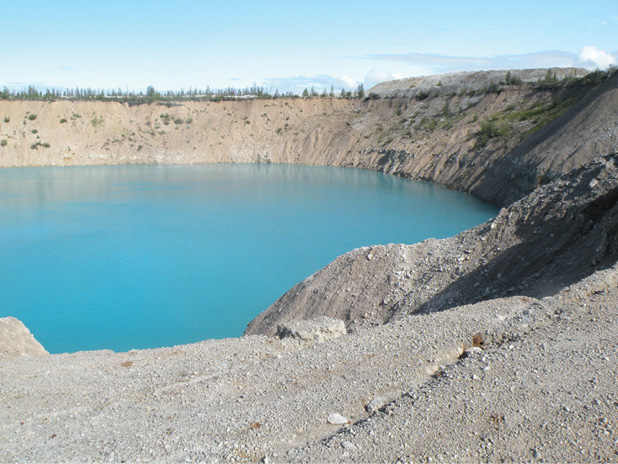
The gravel highway leading east from Hay River, Northwest Territories, features a relatively uniform (some might say monotonous) landscape of flat, spruce and jack pine forest. About 40 kilometers outside of the highway’s terminus at Fort Resolution, a few rock piles near the side of the highway stand out in bold relief. A quick left turn on an unmarked paved road, and one enters a grid of streets, sidewalks, and parking lots — but there are no buildings anywhere. Travel around the site, and it is not hard to stumble on one of the many large open pits that have filled with water, often coloured a brilliant azure blue. Brown grass covering abandoned fairways is all that remains of a nine-hole golf course. Although you might see the odd person, the site is completely abandoned, an industrial ruin that is a mere shadow of what was here before.
From 1964 to 1988, the Pine Point lead-zinc mine operated on the site, one of the biggest and most important mineral developments in the Northwest Territories. Located on the south shore of Great Slave Lake, prospectors surveyed the site as early as 1898, but development only accelerated 50 years later, when the Canadian government granted Consolidated Mining and Smelting Company (CM&S) a 1295-km2 concession at Pine Point with exclusive exploration rights. At the time, the government regarded Pine Point as the centrepiece of its northern development program, eventually offering nearly
$100 million dollars to help build a railway, highway, and hydro dam to kickstart the mine.

To house the mine’s large workforce, the government and CM&S envisioned an orderly, planned town, that would be neither a hardscrabble camp nor a company-owned settlement. Instead, the government and industry would create an idyllic, suburban-style town, with high quality housing, top-notch schools, and ample recreational opportunities. Pine Point might lack the local colour of the frontier mining town, but its designers gladly traded saloons and dance halls for a stable, family-oriented town that would retain workers in a relatively remote location. The plan worked out spectacularly well. The 1200 to 1500 people who lived in Pine Point at any given time remember it as an idyllic town, so much so that an active online community of Pine Pointers has kept the town “alive” on the internet, posting photos and memorabilia to the “Pine Point Revisited” website organized by local legend Richard Cloutier, who sadly passed away in 2021.
Inspired by Cloutier, media artists Paul Shoebridge and Michael Simons created a web-based interactive documentary, “Welcome to Pine Point,” that mixes photos, videos, and residents’ memories to create a nostalgic reverie for Pine Point. One former resident summed up the prevailing sentiment: “Looking in, it is hard not to think that it was a great time to be alive and up north, in a time before seatbelts and sunscreen, when you could still pull block-long wheelies without fear of judgement or consequences.” The photographs and film footage show a modern town with exceptional recreational opportunities: baseball, organized basketball, the aforementioned golf course, a curling rink, outstanding fishing, and an arena (the documentary features remarkable footage of an ice dance performance of The Wizard of Oz). As one scrolls through “Welcome to Pine Point,” it is hard to disagree with one resident’s statement that, “most Pine Pointers think their hometown was the best place on earth to have lived.”
The nearby Dene community of Fort Resolution has a somewhat more mixed recollection of Pine Point. When I participated in an oral history project about Pine Point in 2009, many in the community expressed frustration that the highway to the mine was not extended to their community until 1972, making it difficult to access employment at the mine. Others noted the lasting impact of pits, haul roads, seismic lines, and the tailings ponds on hunting and trapping activities in the Pine Point area, recalling the many ways the mine had changed the land-based culture of the Fort Resolution Dene.
Despite these issues, residents of Fort Resolution who moved to Pine Point were almost unanimous in their praise for the town. Many said it had the best of the best of everything, and that they would move back “in a second” if it were ever re-built. While some remembered isolated incidents of racism, most testified to the remarkable social harmony in the town, and the fact that everybody looked out for one another. Some said it was hard to move back to Fort Resolution (a smaller town with more limited services) after the mine closed.
When the mine did finally close in 1988, the company either flattened or moved all the industrial and residential buildings, leaving the ghost town that remains today. While some of the houses and other buildings could be moved elsewhere (the arena ended up in Fort Resolution, for instance), a major reason for dismantling the town was so squatters would not drift in and inhabit what was no longer an official town. For many Pine Pointers, the fact the town no longer exists accentuates the fond memories.
Their former home is frozen in memory at its absolute best. As a place that has been wiped off the map, it can never change for the worse. According to many former residents, demolishing the town was better than witnessing its slow decline. For all the successes at Pine Point, the heyday of family-oriented mining towns was coming to an end by the early 1980s. The last incorporated town built specifically to support a mine was Tumbler Ridge, B.C., incorporated in 1981. Canadian mining companies have largely turned to flying workers in and out of well-serviced camps. What is lost with such arrangements is the community cohesion and the strong bond between people and place that occurs in mining towns such as Pine Point.
For the “Pine Point Revisited” site, see https://www.pinepointrevisited.com/. For the “Welcome to Pine Point” web documentary, see https://www.nfb.ca/interactive/welcome_to_pine_point/.
John Sandlos is a professor in the History Department at Memorial University of Newfoundland and the co-author (with Arn Keeling) of “Mining Country: A History of Canada’s Mines and Miners,” published by James Lorimer and Co. in 2021. His new book on the history of Giant Mine (also co-authored with Arn Keeling), will be released with McGill-Queen’s University Press in 2025.




